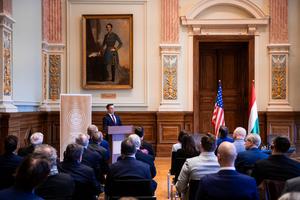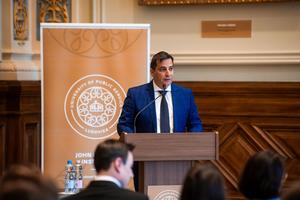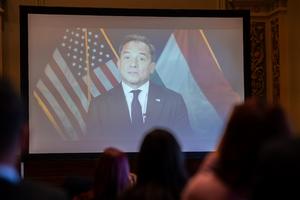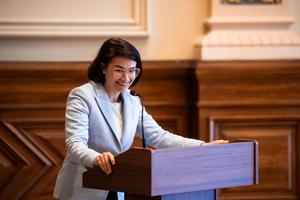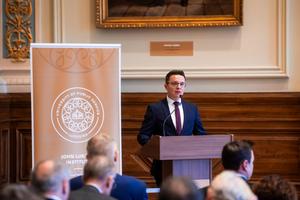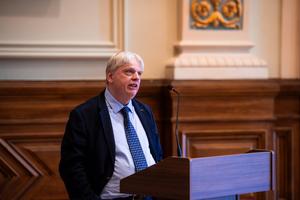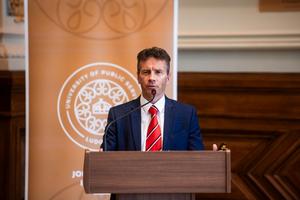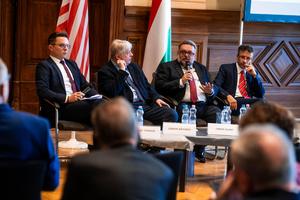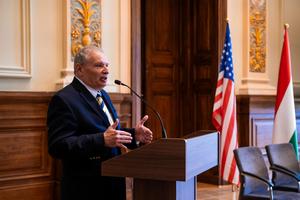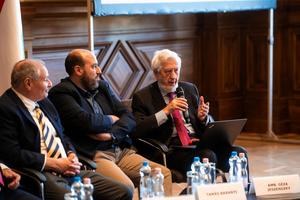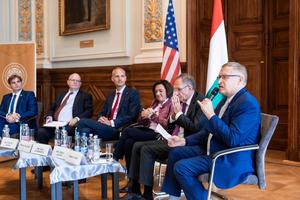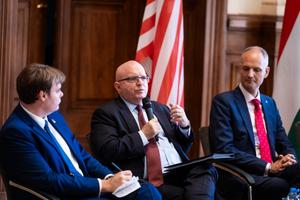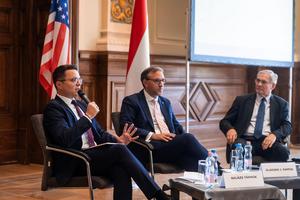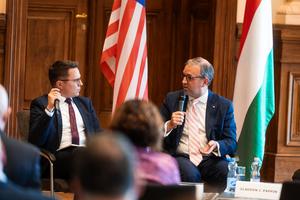This year we celebrate the 100th anniversary of the American–Hungarian Treaty of Friendship, Commerce, and Consular Relations. The John Lukacs Institute (JLI) of the Eötvös József Research Center (EJKK) at Ludovika University of Public Service (LUPS), the United States Embassy in Budapest, the Hungary Foundation, and the Hungarian–American Fulbright Commission organized an international conference on this occasion on October 7 in the LUPS Széchenyi Grand Hall.
The aim of the event was to commemorate in a fitting manner the bilateral Treaty of Friendship, Commerce, and Consular Relations signed in Washington on June 24, 1925, which was a historic milestone in the official relations between the two countries. Therefore, the event aimed not only to review the diplomatic, political, and economic cooperation of the past hundred years but also to present the challenges and opportunities of the present and the future.
Gergely Deli, rector of Ludovika University of Public Service (LUPS), emphasized LUPS’s threefold mission in his welcoming remarks. First, LUPS is committed to the ideal of good governance, which is based on cooperation across different branches of public service as well as international partnerships. Accordingly, it is both a privilege and a duty for LUPS to organize an event where experts, government officials, and diplomats who support successful bilateral cooperation can share their thoughts on the development and key milestones of Hungarian–American relations. The second pillar of LUPS’s mission is academic excellence, meaning that it functions as a center of knowledge in the fields of security, public administration, diplomacy, and many other disciplines. This multidisciplinary profile is also reflected in the John Lukacs Institute, responsible for organizing the conference, whose research focuses on the United States and transatlantic relations, as well as the political, security, and economic dynamics of China and the Indo-Pacific region, with special attention to strategic and defense considerations. Moreover, LUPS’s mission lies in serving the common good: university education and research competencies must also be applied broadly to noble and public-interest purposes, which in practice is embodied in partnerships that highlight Hungarian efforts and outstanding scientific achievements achieved in the name of professional excellence and the common good. In this light, Gergely Deli emphasized that the Széchenyi Grand Hall on the Ludovika Campus is a fitting location for commemorating the centenary of the American–Hungarian Treaty of Friendship, Commerce, and Consular Relations, as the Hungarian signatory of the treaty was Count László Széchenyi, whose grandfather, Count Lajos Széchenyi, financially supported the establishment of the Ludovika Academy.
Robert Palladino, Chargé d’Affaires of the United States in Budapest, addressed participants via video message. In his speech, he emphasized that the 1925 Treaty of Friendship, Commerce, and Consular Relations was not only a diplomatic agreement but also a statement of commitment to shared values and partnership between the two peoples. Accordingly, the most important element of the document’s title is not commerce or consular rights, but friendship, which indicates that the bond exists not only politically or transactionally, but in a civilizational sense. Although the two countries have not always been on the same side over the past 100 years, the American chargé reminded the audience that personal ties have persisted. Robert Palladino recalled, among other events, the reception of refugees from 1956, the provision of asylum to Cardinal József Mindszenty, the return of the Holy Crown, and President George H. W. Bush’s visit to Budapest in 1989. He added that the American–Hungarian partnership is based on enduring principles—freedom, faith, family, and sovereignty—which continue to inspire cooperation today. Looking to the future, Palladino emphasized the importance of energy security, national sovereignty, and investments that ensure jobs and prosperity, urging the renewal of the partnership. He stressed that civilizational allies do not merely sign agreements or comply with bureaucratic requirements; they also invest in and protect one another. He concluded that if we remain faithful to the principles of sovereignty, prosperity, and respect, the U.S.–Hungarian relationship will not only endure but flourish.
Boglárka Illés, State Secretary responsible for bilateral relations at the Ministry of Foreign Affairs and Trade, also spoke at the event, evaluating the American–Hungarian friendship from a Hungarian perspective. She emphasized that the two countries’ relationship is characterized by shared values, along the lines of freedom, independence, and national identity. The State Secretary reminded participants that today’s challenges—security threats, humanitarian crises, and global economic issues—can only be addressed through cooperation. She highlighted that from 2025 onwards, a new “golden age” has begun in the bilateral relationship, which is not merely a slogan but a real development, and the Hungarian–American relationship will continue to be built on mutual respect and trust in the future.
The first session of the conference was titled “American–Hungarian Relations in the First Half of the 20th Century”, moderated by Balázs Tárnok, research director at JLI. Gábor Bátonyi, lecturer at the University of Bradford, presented “The Anglo-Saxon World and the Dissolution of the Austro-Hungarian Monarchy”, reminding the audience that early 20th-century British and American leaders believed the monarchy was undergoing a slow and gradual decline: in December 1914, U.S. President Woodrow Wilson stated, “Austria–Hungary will completely fall apart—and in a sense, it must fall apart for the good of Europe.” Bátonyi emphasized that for the United States, friendship with the Austro-Hungarian Monarchy was more a concern than a benefit, as it was closely tied to the persistent issue of mass emigration. He also explained that strong Russian influence existed in both the U.S. and the U.K., and no one wanted direct confrontation with Russia until 1918. Later, Anglo-American perceptions of the Habsburgs fluctuated, occasionally re-evaluating the monarchy’s legacy.
Tibor Glant, research professor at the John Lukacs Institute and lecturer at the University of Debrecen, presented “Establishing a Modus Operandi: Laying the Foundations of American–Hungarian Bilateral Relations”, explaining that although the two countries were formally at war between 1917 and 1921, no actual fighting took place. The peace treaty and restoration of diplomatic relations occurred between 1921 and 1925: the American side initially hesitated but gradually recognized Hungary’s independence, leading to the Treaty of Friendship, Commerce, and Consular Relations. Glant noted that the relationship was always characterized by asymmetry—Hungary viewed the United States as a strategic partner, while the U.S. regarded Hungary as a regional concern. From post-war chaos, the modern Hungarian–American partnership gradually developed, founded on friendship, independence, and mutual respect.
Zoltán Peterecz, associate professor at Eszterházy Károly Catholic University, presented “American Ambassadors in Hungary Between the Two World Wars”, examining how the United States’ envoys to Budapest—Theodore Brentano, Nicholas Roosevelt, John F. Montgomery, and Herbert Pell—viewed Hungary and the Hungarians during the 1920s and 1930s. He emphasized that these American representatives were not professional diplomats but mostly political appointees (party-affiliated, mainly Republicans) who often arrived in Hungary with little experience but strong personal ambition.
László Borhi, professor at Indiana University, presented “American–Hungarian Relations During the Cold War”, illustrating how Hungary’s foreign policy depended on the Soviet–American relationship. He explained that Hungary was only legally sovereign between 1945 and 1990, being effectively under Soviet influence, so Hungarian–American relations did not exist independently but were contingent on the Soviet–American dynamic. After 1947, a realist containment policy prevailed, yet the U.S. remained engaged with Hungary: through American mediation, Hungary recovered its gold reserves, and the U.S. prevented the full expulsion of German and Hungarian minorities. However, from 1948 onward, due to the Berlin Blockade and Soviet expansion, the U.S. fully committed to isolating communist regimes. Relations remained distant but gradually normalized until the end of the Cold War.
The panel “American–Hungarian Relations During the Cold War and the Transition Period” included Tibor Glant, László Borhi, Géza Jeszenszky, former Hungarian foreign minister, and Tamás Baranyi, strategic director of the Hungarian Foreign Policy Institute. They reviewed the history of U.S.–Hungary relations, with particular focus on the transition period and subsequent years. They highlighted President George H. W. Bush’s 1989 visit, which had a significant impact on Hungarian society, and Hungary’s definitive choice of a Western orientation in 1990. They discussed NATO accession preparations, supported by President Bill Clinton. It was noted that the U.S. has always shown sympathy toward Hungary, even when politically at odds. During the Cold War, the U.S. was highly popular in Hungary, despite relations being simultaneously characterized by isolation, pressure, and friendly outreach.
The panel “Contemporary American–Hungarian Relations” focused on the development of the relationship in the post-transition decades, recent developments, and future prospects. Moderated by Gábor Csizmazia, head of the JLI America Research Program, the participants explored diplomatic, security, economic, and cultural aspects. Philip T. Reeker, partner at Albright Stonebridge Group’s Europe and Eurasia division and former deputy chief of mission at the U.S. Embassy in Budapest, provided a historical overview based on his experience in Hungary since 1989. He highlighted U.S. foreign policy toward Central Europe from the Cold War to the present, from supporting democratic transitions to post-9/11 counterterrorism and the Trump-era “America First” approach. Márton Ugrósdy, Deputy State Secretary at the Prime Minister’s Office, stressed the importance of security guarantees in the current European geopolitical environment and highlighted economic ties. The panel included two Hungarian ambassadors to Washington, D.C.: Réka Szemerkényi, director for international affairs at the Equilibrium Institute, addressed geopolitical changes and their security implications, while György Szapáry, senior advisor to the president of the Hungarian National Bank, emphasized U.S. investments and EU–U.S. economic relations. Károly Jókay, executive director of the Hungarian–American Fulbright Commission, stressed the importance of cultural and educational ties, noting that Hungarian state support for the Fulbright program increased sevenfold between 2022 and 2025. He added that it is essential for Fulbright participants to serve as cultural ambassadors representing their country and fostering mutual understanding.
The closing discussion, “The Future of American–Hungarian Relations”, was moderated by Balázs Tárnok, featuring Gladden J. Pappin, president of the Hungarian Foreign Policy Institute, and Tamás Magyarics, professor emeritus at ELTE. Pappin stated that U.S.–Hungarian relations are strong, but the international order is transforming: the liberal world order is weakening, the West’s relations are entering new frameworks, and the U.S. is increasingly defining foreign policy based on national interests, withdrawing from global engagement and focusing on domestic issues. Hungary aligns with this approach in several respects, prioritizing national sovereignty and independent security policy. Magyarics highlighted that the friendship is grounded in civilizational closeness and shared values, though opinions do not coincide on everything. Hungary is no longer the U.S.’s key regional partner as in the 1990s; today, Poland and Romania play that role. Military cooperation remains excellent, with Hungary significantly increasing defense spending. There are some differences in assessing the Russia–Ukraine war, but the strategic direction is similar: both the U.S. and Hungary support the war’s swift conclusion. He noted that possible changes in U.S. domestic politics (the 2026 and 2028 elections) may influence the relationship’s future, but the current favorable environment is expected to continue.
Text: Éva Harangozó
Photo: Dénes Szilágyi
